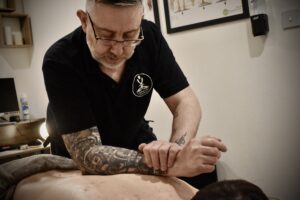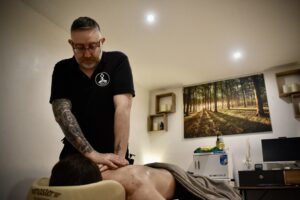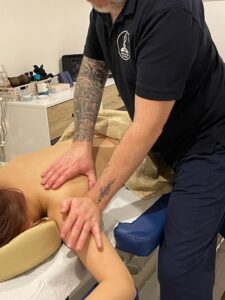#1 Clinical Massage Therapy
What is Clinical Massage?
Clinical massage is a targeted, evidence-based form of manual therapy that focuses on assessing and treating musculoskeletal pain and dysfunction. Unlike general relaxation massage, clinical massage is designed to address specific medical conditions or injuries through a combination of soft tissue manipulation techniques. It is often used alongside other therapies such as physiotherapy.
Practitioners of clinical massage use an in-depth understanding of anatomy, physiology, and pathology to assess each patient’s needs and develop a personalised treatment plan. Techniques may include deep tissue massage, trigger point therapy, myofascial release, neuromuscular therapy, and stretching. The ultimate goal is to restore function, reduce pain, and support the body’s natural healing processes.
Clinical massage is commonly integrated with Clinical Orthopaedic Manual Therapy (COMT), a specialised approach that blends massage therapy with orthopaedic assessment and treatment techniques. COMT practitioners are trained to evaluate joint mechanics, soft tissue function, and movement patterns, allowing for highly specific interventions.
COMT - Clinical Orthopaedic Manual Therapy
Clinical Orthopaedic Manual Therapy (COMT) is an advanced, hands-on approach to the assessment and treatment of musculoskeletal dysfunction. Rooted in orthopaedic principles and clinical reasoning, COMT integrates detailed anatomical knowledge with specialised manual techniques to address pain, movement restrictions, and joint dysfunctions.
Practitioners of COMT are trained to perform thorough physical assessments, including joint mobility testing, postural analysis, and soft tissue evaluation. This allows them to identify the specific source of a patient’s symptoms, whether it be joint misalignment, muscular imbalance, or fascial restriction.
Treatment techniques used in COMT may include joint mobilisation, manipulation, soft tissue release, myofascial techniques, neuromuscular re-education, and guided therapeutic exercises. The goal is not just pain relief, but restoring optimal function, improving mobility, and preventing future injury.
COMT is particularly effective for treating conditions such as back pain, neck pain, shoulder impingement, sports injuries, and repetitive strain syndromes.
By combining clinical expertise with evidence-based manual therapy, COMT offers a highly individualised and effective pathway to recovery and long-term musculoskeletal health.

Benefits of Clinical Massage
Clinical massage offers a range of therapeutic benefits, particularly for individuals dealing with pain, injury, or chronic conditions. Below are some of the key advantages:
1. Pain Relief
Clinical massage is widely recognised for its ability to alleviate both acute and chronic pain. By targeting the underlying cause of pain—whether it’s muscle tension, trigger points, nerve entrapment, or soft tissue restrictions—massage helps reduce discomfort without relying on medication.
A study published in the Annals of Internal Medicine (Cherkin et al., 2011) found that massage therapy was effective in reducing chronic low back pain, often outperforming standard medical care.
2. Injury Rehabilitation
Whether you’re recovering from a sports injury, surgery, or a repetitive strain condition, clinical massage can support the healing process by improving circulation, reducing scar tissue, and promoting tissue regeneration. This is particularly beneficial in post-operative or post-traumatic recovery phases.
3. Improved Mobility and Function
Restricted movement can result from muscle tightness, joint dysfunction, or fascial adhesions. Clinical massage techniques help to restore range of motion and improve flexibility, making it easier for patients to perform daily activities without pain or limitation.
4. Postural Correction and Ergonomic Support
Poor posture is a common cause of musculoskeletal issues. Clinical massage can help correct muscle imbalances and relieve strain caused by long hours of sitting or repetitive work patterns. It’s frequently used to manage conditions such as forward head posture, rounded shoulders, or lower back strain.
5. Stress and Tension Reduction
While clinical massage is medically focused, it still offers the well-known relaxing benefits of traditional massage. Reducing physical tension can have a profound effect on mental well-being, lowering cortisol levels and promoting a sense of calm.
According to the Journal of Clinical Psychiatry (Field et al., 2005), massage therapy has been linked to reductions in anxiety and depression symptoms, especially when used consistently over time.
6. Support for Chronic Conditions
People with conditions such as fibromyalgia, arthritis, and chronic fatigue syndrome often benefit from clinical massage. Gentle techniques tailored to the individual’s tolerance can help manage symptoms and improve quality of life.
Helping You Be At Your Best
Because we look at the way your whole body moves, and not just the area of pain, it makes us the #1 expert massage therapist of choice for sports injuries and other soft tissue problems. Is there a recurrent knee pain, back pain that just won’t go away? By looking at the biomechanics of your whole body, we often find there are problems – a slight niggle, a slight back pain or shoulder pain that was just beginning to register with you. Does that sound familiar?
Often compensatory patterns occur and you find that the other uninjured side now starts to ache. Using Clinical massage therapy techniques means we can not only identify these imbalances, but work on them and get you back to doing the things you love the most.

Techniques
Specific massage techniques to balance the nervous system. Ischemic compression on trigger points to relieve pain.
Passive stretching to improve range of motion. Active stretching to engage the client in the process.
To further help with tight muscles, a therapist guided contract and relax method of gaining further pain relief and mobility throughout the body
Effleurage: Long, sweeping strokes to warm up the muscles. Petrissage: Kneading and squeezing motions to release tension.
Identifying and applying pressure to trigger points to alleviate pain. Ischemic compression to release tight knots in muscles
Gentle movements to improve joint flexibility. Rotation and oscillation techniques to enhance joint function.
Technique for muscle contraction and stretching used to increase flexibility, for releasing tight muscles and ROM.
Slow, firm pressure targeting deeper muscle layers. Cross-fiber friction to break up adhesions and scar tissue.
Friction applied across muscle fibers to break up adhesions. Useful for addressing scar tissue and improving mobility and painful areas.
Applying sustained pressure to release tension in the fascia. Stretching and lengthening techniques to improve flexibility.




